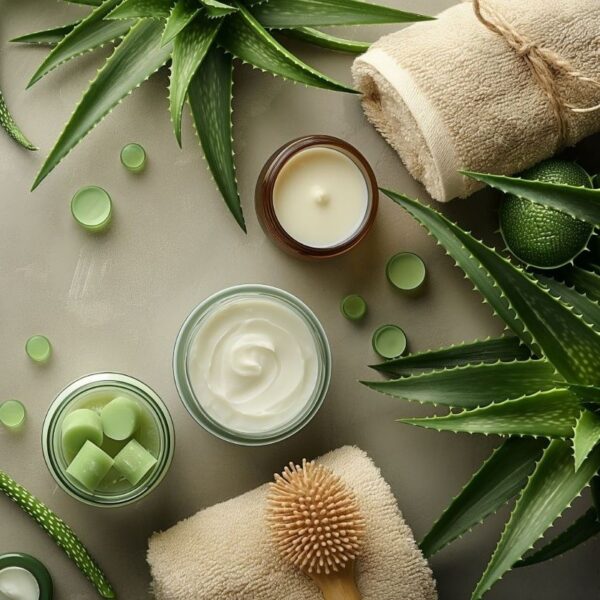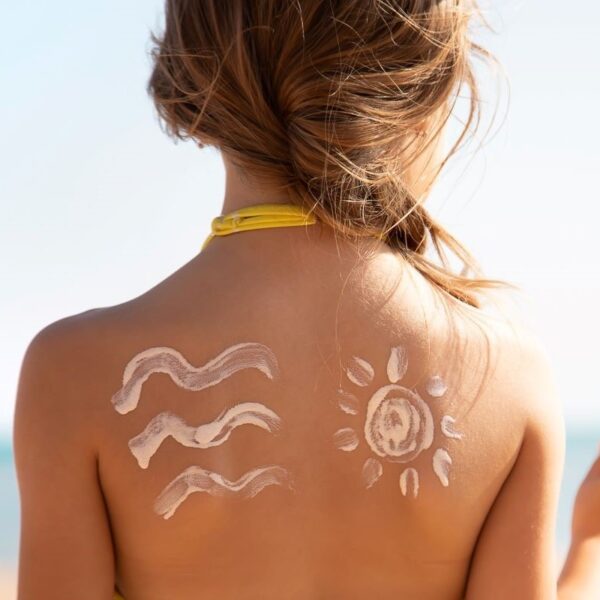Butylphenyl Methylpropional (BMHCA) is a fragrance ingredient commonly known by its trade name, Lilial. It has an attractive floral scent and is used in certain cosmetics, topical personal care products, and perfumes.
What is Butylphenyl Methylpropional?
Butylphenyl Methylpropional, chemically known as 2-(4-tert-Butylbenzyl) propionaldehyde, is used as a fragrance ingredient in many compounds for cosmetic and personal care products.
It’s also used as a fragrance in biocidal products, coatings and paints, fillers/plasters, ink/toners, polishes/wax blends, and scented products. However, BMHCA should not be used in food products or products applied on or near the mouth.
Source: Wikipedia
Butylphenyl Methylpropional is generally produced and sold as a racemic mixture, a mixture of equal quantities of two enantiomers or substances with dissymmetric molecular structures that mirror one another. However, testing indicates that the different enantiomers of the compound do not contribute equally to its odor. The (R)-enantiomer has a strong floral scent reminiscent of cyclamen or lily of the valley, whereas the (S)-enantiomer possesses no strong aroma.
Use & Application of Butylphenyl Methylpropional in Cosmetics & Personal Care Products
Butylphenyl Methylpropional is used for various dermal products, including cosmetics, fine fragrances, shampoos, soaps, hair care products, skincare products, and other toiletries. However, it is not used in lip, toothpaste, or mouthwash products.
The degree of purity of BMHCA can be as high as ≥99.5% (w/w). Possible impurities include 3-(3-tert-Butylphenyl)-2-methylpropanal and lysmerylic (lilac) acid—the latter compound results from air oxidation in aqueous solutions at pH7 and 25°C. However, since BMHCA is susceptible to auto-oxidation, alpha-tocopherol (CAS 59-02-9) is added as a stabilizer directly after production.
Product Examples
| Type | Examples |
| Hydroalcoholic-Based Fragrances | Perfume, After Shave, Cologne, Deodorants |
| Makeup Products | Eye Makeup, Makeup Remover, Liquid Foundation, Mascara, Eyeliner |
| Skin Care | Face Cream, Hand Cream, Body Lotion |
| Hair Care | Shampoo, Conditioner, Hair Styling Products |
| Bath and Shower | Shower Gel, Soaps |
Properties of Butylphenyl Methylpropional
| Physical Form | Transparent liquid |
| Color | Colorless to pale yellow |
| Odor | Mildly floral, reminiscent of cyclamen and lily of the valley |
| Molecular Weight | 204.31 g/mol |
| Density @ 25°C | 0.94 at 25°C |
| Viscosity in mPa.s at 20°C | 12.3 |
| Melting Point | <–20°C |
| Boiling Point | 279.5°C |
| Refractive Index | 1.503 – 1.507 |
| Specific Gravity (at 25°C) | 0.9420 – 0.9490 |
| Solubility | 33 mg/L at 20°C (in water) |
| Shelf Life | 12 Months |
| Storage Temperature & Conditions | Store in a cool place away from heat and sources of ignition. |
Typical Formulations
Body Refresher Cleansing Mist
Here is a formulation phase table for a body spray that hydrates, tones, and refreshes skin. It provides waterless cleansing by solubilizing dirt and oil without foaming. It also moisturizes and protects the skin.
| PHASE | INCI Name | TRADE Name | % Wt. |
| A | Water | – | q.s |
| Glycerin | – | 2.0 | |
| Fragrance (Butylphenyl Methylpropional-Lilac) | – | 1.0 | |
| Glycolipids | ACS Sophorolipids | 1.0 | |
| Glycolipids + Caprylyl/Capryl Glucoside + Sodium Cocoyl Glutamate + Olive Oil Polyglyceryl-6 Esters + Water | Tera Solve | 3.0 | |
| Zinc Poly Itaconate | Revcare MC | 2.0 | |
| Phenoxyethanol | Preservative | 1.0 | |
| Total | 100 | ||
Source: Knowde
Formulation Procedure
- Combine all ingredients and mix until uniform.
The resulting product will be a transparent liquid, with a s stability passed 3 cycles F/T.
Butylphenyl Methylpropional Formulation Considerations
| Physical Forms | Liquid |
| Stability | Lilial® (p-BMHCA) undergoes significant oxidation (about 30% during a period of 168 h). Alpha-tocopherol is usually added to stabilize the compound. |
| Sensory Attributes | Lilial® (p-BMHCA) undergoes significant oxidation (about 30% during 168 h). Alpha-tocopherol is usually added to stabilize the compound. |
| Source | Synthetic, racemic mixture |
Personal care product formulations containing butylphenyl methylpropional sometimes also include niacinamide, a form of vitamin B3 with benefits for the skin, and ethanolamine, which is used as a pH adjuster.
Safety & Regulatory Considerations
- Butylphenyl Methylpropional is classified as a carcinogenic, mutagenic, or reprotoxic (CMR) category 1B substance under the EU and GB Classification, Labelling, and Packaging (CLP) Regulations. This means it is prohibited in cosmetic products made available in the EU and the UK. Cosmetic products containing BMHCA are not available in the EU or UK.
- In 2019, the SCCS released an opinion on the safety of Butylphenyl Methylpropional in cosmetics products. On an individual product basis, Butylphenyl Methylpropional (p-BMHCA) (CAS 80-54-6) with alpha-tocopherol at 200 ppm can be considered safe when used as a fragrance ingredient in cosmetic leave-on and rinse-off type products. However, considering the first-tier deterministic aggregate exposure arising from the use of different product types together, Butylphenyl Methylpropional in the proposed concentrations cannot be considered as safe. The opinion does not apply to the use of p-BMHCA in any sprayable products that could lead to exposure of the consumer’s lung by inhalation.
- The International Fragrance Association (IFRA) Standard restricts the use of Butylphenyl Methylpropional. IFRA recommends a safe concentration limit for Butylphenyl Methylpropional when used in specific categories of cosmetic products as developed by IFRA. According to IFRA’s dossier submitted to the Scientific Committee on Consumers Safety (SCCS), Butylphenyl Methylpropional may be used at a maximum level of 1.42% in hydroalcoholic-fragrances, 0.09% in deodorants, and 0.05% in face and hand creams.
Heath Effects of Butylphenyl Methylpropional
- Fragrance ingredients, including Butylphenyl Methylpropional, are the most frequent culprits in cosmetic allergies, impacting the effectiveness of advertising perfumed products.
- Common symptoms of Butylphenyl Methylpropional-induced contact dermatitis are localized in the axillae, face (including the eyelids), and neck, patches that appear in areas where dabbing-on perfumes are used (wrists behind the ears), and hand eczema.
- Airborne or connubial contact dermatitis should be considered as well. Other less-frequent adverse reactions to fragrances are photocontact dermatitis, contact urticaria, irritation, and pigmentation disorders.
- Sensitization is most often induced by highly perfumed products, such as toilet water, aftershave lotions, and deodorants.
Safety & Toxicity of Butylphenyl Methylpropional
- Skin Irritation: According to the tests carried out, Butylphenyl Methylpropional as a neat compound is revealed to be irritating to the skin and eyes of rabbits. In addition, Butylphenyl Methylpropional in propylene glycol led to mild skin erythema. In general, the observed effects occurred transiently and were reversible. In a special investigation, p-BMHCA also displayed the potential to induce respiratory irritation. In a non-GLP and non-guideline study, occlusive dermal application of neat p-BMHCA on 2-3 rabbits for 5 minutes, 2, or 24 hours resulted in desquamation in all animals at the end of the observation period (8 days) for all exposure periods. Questionable to slight edema (reversible for all exposure periods) and erythema (reversible for 5 min exposure period) were observed. Longer exposure periods led to persisting erythema at the end of the observation period.
- Skin Sensitization: BMHCA was comprehensively tested in experimental animals, primarily according to guideline procedures and under GLP conditions. Several positive LLNA resulted in EC3 values indicative of sensitization. Depending on the solvent, the EC3 values ranged from 2.97% (in EtOH) to 13.91% (in 25% EtOH/75% DEP), and up to 18.7% by application of p-BMHCA in acetone/olive oil (4:1). Another LLNA with EtOH as vehicle showed SI>3 for all tested doses of p-BMHCA (10, 25, 50, 100%). An EC3 value of about 2.9% p-BMHCA in the LLNA has been substantiated by data from the International Fragrance Association directly submitted to SCCS in 2009 (SCCS, 2012). By contrast, GPMTs performed were contradictory and thus ambiguous. Finally, dermal reactions have been observed in a KAO test in guinea pigs. Based on the animal data, the overall potency classification of p-BMHCA is a “moderate sensitizer.”
Identification Numbers
| Chemical Name | Butylphenyl Methylpropional |
| CAS Number | 80-54-6 |
| EC Number | 201-289-8 |
Acceptable Limits or Maximum Usage
The maximum usage level of Butylphenyl Methylpropional in cosmetics as per the SCCS (Scientific Committee on Consumer Safety) is as follows:
| Category | Usage Level |
| Hydroalcoholic-Based Fragrances (e.g., Eau De Toilette, Perfume, Aftershave, Cologne)* | 1.42 |
| Deodorants | 0.09 |
| Makeup Products (Eye Makeup, Makeup Remover, Liquid Foundation, Mascara, Eyeliner) | 0.04 |
| Face Cream | 0.05 |
| Hand Cream | 0.05 |
| Body Lotion | 0.06 |
| Hair Styling | 0.04 |
| Bath Cleansing Products (Soaps, Shower Gel, Rinse-Off Conditioner, Shampoo) | 0.1 |
| *Maximum finished product concentration for hydro alcoholics on shaved skin is 0.6% | |
Source: SCCS
Fun Facts About Butylphenyl Methylpropional
- Due to increasing consumer demand for transparency in fragrance ingredients, Butylphenyl Methylpropional is sometimes labeled as Lilial on product packaging. This alternative name helps consumers identify its presence in a product and make informed choices.
- Butylphenyl Methylpropional is often used to mimic the scent of lilies. It contributes a floral, sweet, and powdery aroma to perfumes and other scented products.





